Growing tomatoes in pots is an ideal solution for urban gardeners, balcony enthusiasts, or anyone with limited garden space. Container gardening allows you to enjoy fresh, juicy tomatoes without needing a traditional garden bed. With the right techniques, proper pot selection, and attentive care, even a small patio can yield an abundant tomato harvest. This guide provides a comprehensive step-by-step approach for growing tomatoes in pots successfully.
Why Grow Tomatoes in Pots?
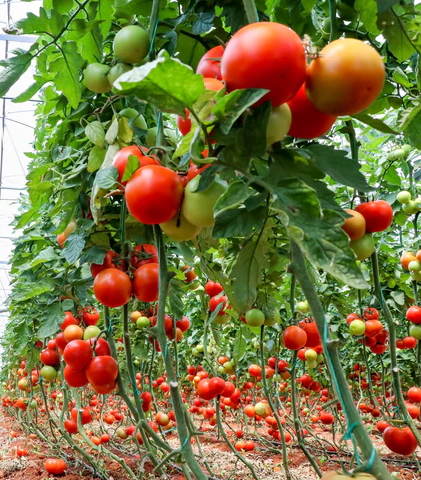
Tomatoes are one of the most popular homegrown vegetables due to their versatility, flavor, and nutritional value. Growing them in pots offers several advantages:
- Space Efficiency: Perfect for patios, balconies, and small yards.
- Mobility: Pots can be moved to maximize sunlight or avoid extreme weather.
- Pest Control: Easier to manage pests and diseases compared to in-ground planting.
- Soil Control: You can customize soil mix for optimal growth and fertility.
- Extended Growing Season: Containers can be relocated to warmer areas or indoors in cooler climates.
However, container-grown tomatoes require careful attention to watering, fertilization, and support to produce juicy, healthy fruits.
Choosing the Right Tomato Varieties for Pots
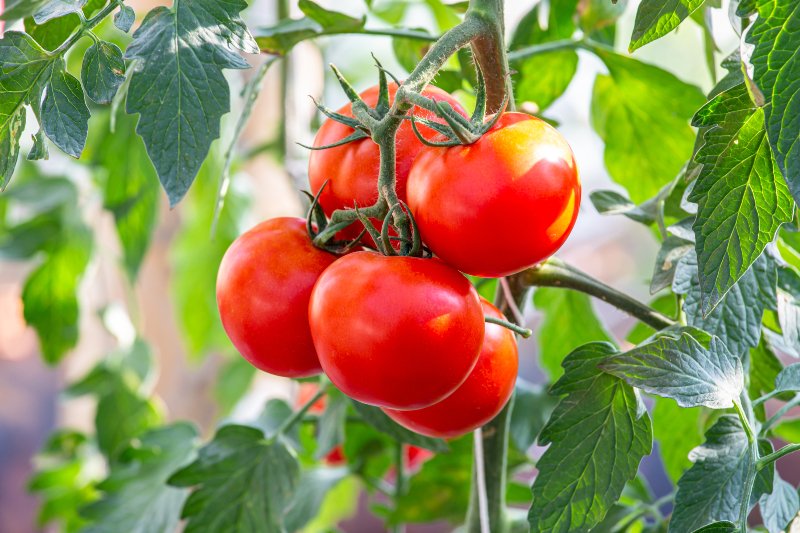
Not all tomatoes thrive in pots. Selecting the right variety ensures better growth and harvests.
Best Choices for Container Gardening:
- Determinate Varieties (Bush Tomatoes):
- Grow to a compact height (2–3 feet) and stop growing once fruit sets.
- Ideal for smaller containers and limited space.
- Examples: ‘Bush Early Girl,’ ‘Patio Princess,’ ‘Tiny Tim.’
- Indeterminate Varieties (Vining Tomatoes):
- Continue growing and producing fruit throughout the season.
- Require larger pots and sturdy support structures.
- Examples: ‘Cherry Tomatoes,’ ‘Sungold,’ ‘Big Boy.’
Tips:
- Choose varieties labeled “container-friendly” or “patio” for optimal results.
- For limited space, cherry or grape tomatoes are highly productive and compact.
Selecting the Right Pots
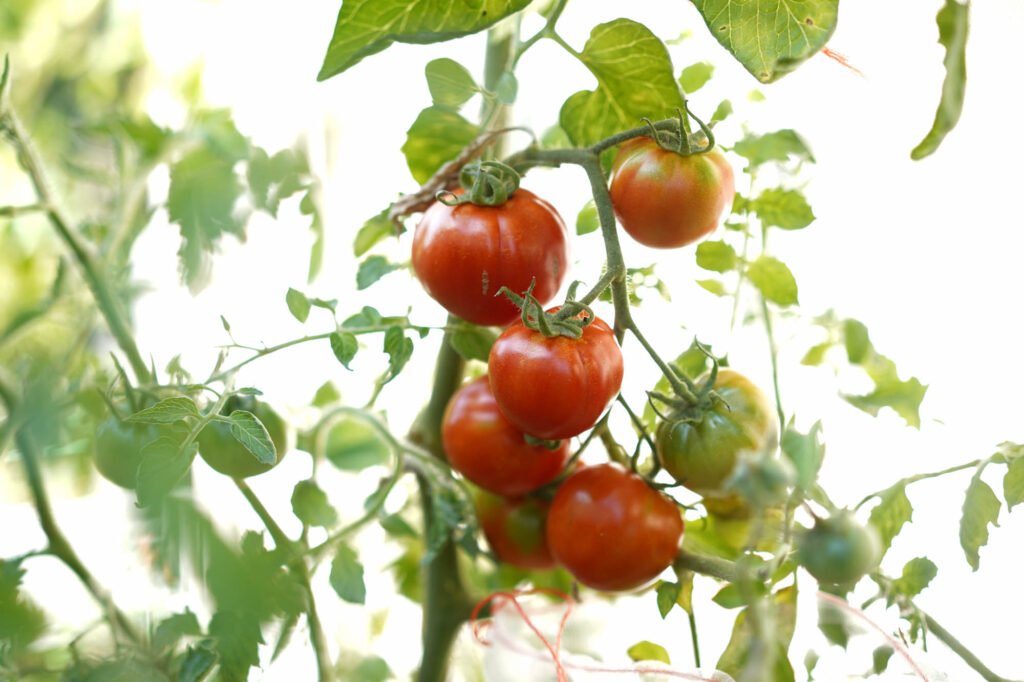
The container is as important as the plant itself. Tomatoes need adequate root space, drainage, and stability.
Ideal Container Features:
- Size:
- Determinate varieties: 5–7 gallons (19–26 liters)
- Indeterminate varieties: 10–15 gallons (38–57 liters)
- Material:
- Plastic: lightweight and retains moisture.
- Clay: porous and allows air exchange but dries faster.
- Fabric grow bags: lightweight, portable, and promote air pruning of roots.
- Drainage: Ensure multiple drainage holes to prevent waterlogging.
Tip: Place saucers under pots to catch excess water but avoid letting roots sit in standing water.
Choosing the Right Soil Mix
Tomatoes are heavy feeders that require fertile, well-draining soil.
Recommended Soil Mix:
- 50% high-quality potting soil
- 25% compost (for nutrients and organic matter)
- 25% perlite or coarse sand (for drainage)
Tips:
- Avoid garden soil alone, as it can compact in pots and restrict root growth.
- Ensure soil is slightly acidic with a pH of 6.0–6.8.
- Add slow-release fertilizer or tomato-specific potting mix for sustained nutrition.
Planting Tomatoes in Pots
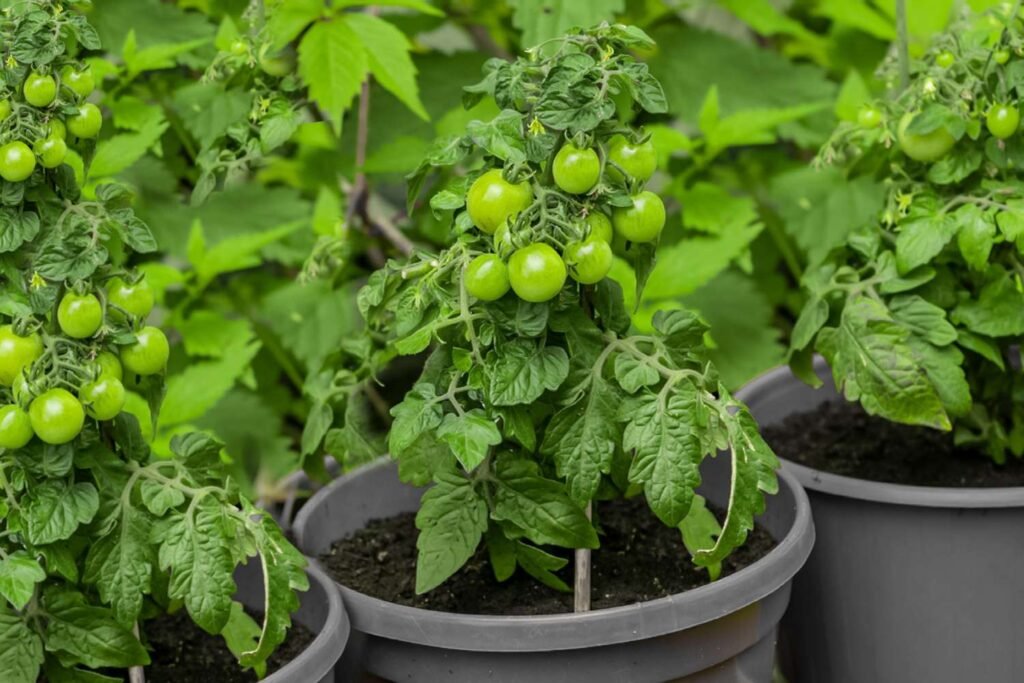
Steps for Successful Planting:
- Prepare the Container: Fill the pot with the prepared soil mix, leaving 2–3 inches from the rim.
- Plant Deep: Tomatoes can develop roots along buried stems. Plant them up to the first set of true leaves.
- Water Thoroughly: Moisten soil evenly to settle roots.
- Space Considerations: Avoid crowding multiple plants in one pot; one tomato per container is ideal.
Tip: For indeterminate varieties, consider staking or using a tomato cage at planting to support vining growth.
Watering Tomatoes in Pots
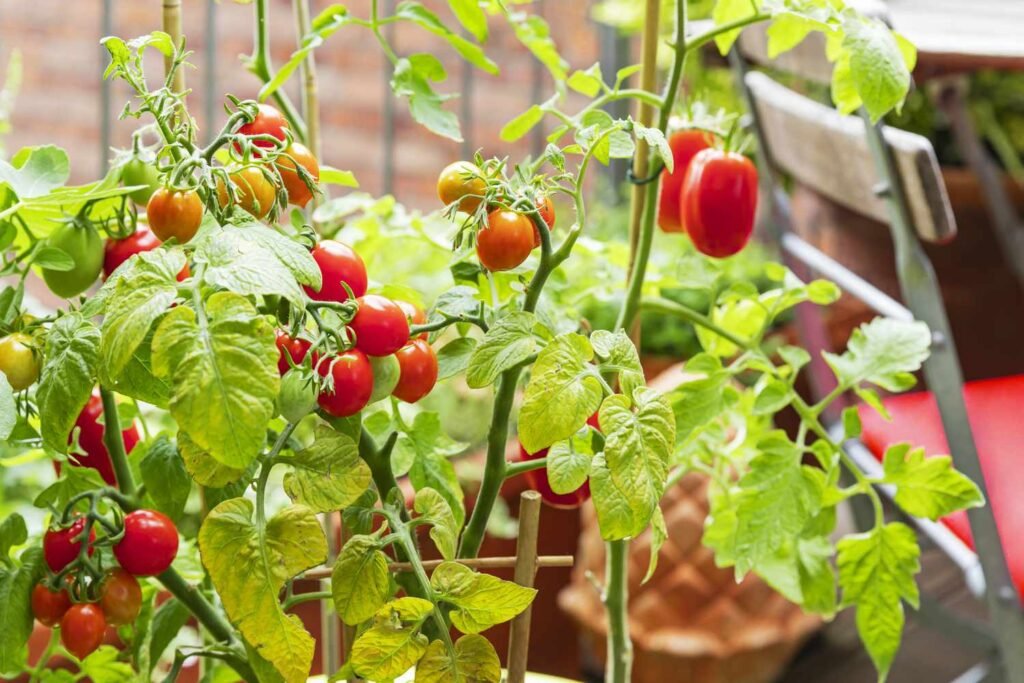
Container tomatoes dry out faster than in-ground plants. Consistent moisture is key to juicy fruits.
Watering Guidelines:
- Water deeply once or twice daily in hot weather.
- Ensure the soil remains moist but not soggy.
- Use mulch (straw, shredded leaves, or bark) to retain moisture and regulate soil temperature.
Tip: Avoid wetting foliage, as it can promote fungal diseases.
Fertilizing for Maximum Yield
Tomatoes are nutrient-hungry and require regular feeding.
Fertilization Schedule:
- At Planting: Mix in slow-release fertilizer or compost.
- Early Growth: Use a balanced liquid fertilizer every 2 weeks.
- Flowering and Fruit Set: Switch to high-phosphorus fertilizer to support blooms and fruit development.
- Throughout Season: Fertilize every 2–3 weeks with tomato-specific liquid feed.
Tip: Avoid over-fertilizing nitrogen, as it promotes foliage growth at the expense of flowers and fruits.
Supporting and Pruning Tomatoes
Proper support and pruning improve air circulation, sunlight penetration, and fruit quality.
Support Techniques:
- Tomato cages: Ideal for determinate varieties.
- Stakes or trellises: Required for indeterminate vining types.
- String supports: Effective for patio spaces with vertical growth.
Pruning Tips:
- Remove suckers (side shoots) to focus energy on fruiting.
- Trim lower leaves to reduce soil-borne diseases.
- Avoid excessive pruning, as foliage protects fruits from sunscald.
Managing Pests and Diseases
Tomatoes in pots are less prone to pests than garden beds but still require monitoring.
Common Issues:
- Aphids and whiteflies: Spray with insecticidal soap.
- Fungal diseases (blight, powdery mildew): Ensure good air circulation, avoid wet foliage, and rotate pots if possible.
- Blossom end rot: Caused by inconsistent watering and calcium deficiency; maintain even moisture and consider adding calcium-rich fertilizer.
Harvesting Juicy Tomatoes
Signs of Ripeness:
- Fruits are fully colored according to their variety.
- Slightly soft to the touch but firm enough to hold shape.
- Detach easily from the stem with a gentle twist or scissors.
Tips for Maximum Flavor:
- Harvest in the morning for best flavor.
- Allow fully green fruit to ripen indoors if frost approaches.
- Rotate harvested plants to encourage continuous fruit production.
Additional Tips for Patio Tomato Success
- Sunlight: Tomatoes need 6–8 hours of direct sunlight daily.
- Temperature: Maintain day temperatures of 70–85°F (21–29°C) for optimal fruit set.
- Container Mobility: Move pots to sheltered areas during extreme weather.
- Companion Planting: Grow basil or marigolds nearby to deter pests and improve growth.
- Regular Maintenance: Deadhead flowers and remove yellowing leaves to encourage new growth.
Conclusion
Growing tomatoes in pots is a rewarding and practical solution for gardeners with limited space. By carefully selecting container-friendly varieties, providing the right soil mix, consistent watering, and proper fertilization, you can enjoy juicy, flavorful tomatoes straight from your patio.
The key steps for success include:
- Choose determinate or compact varieties for container gardening.
- Use well-draining, nutrient-rich soil and adequately sized pots.
- Water consistently and mulch to retain moisture.
- Provide support and prune regularly to promote healthy fruit production.
- Monitor for pests and diseases and harvest fruits at peak ripeness.
With proper planning and care, your patio can become a productive tomato haven, delivering fresh, delicious fruits throughout the growing season. Container tomatoes not only provide a bountiful harvest but also add vibrancy and greenery to urban living spaces, making them a favorite choice for home gardeners everywhere.
